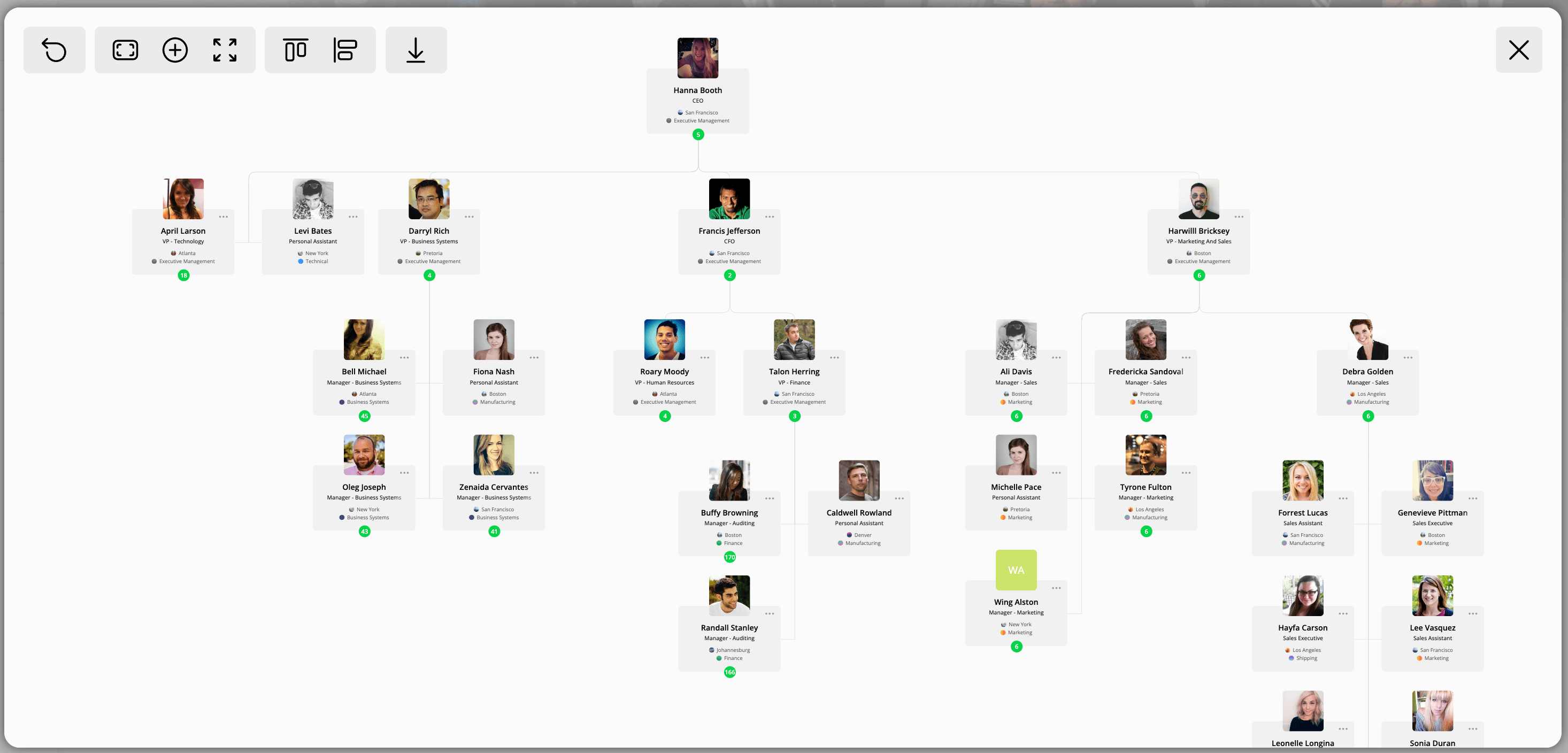What Exactly is a Hierarchy Chart?
Explore the intricacies of hierarchy charts in our comprehensive guide. Learn what they are, their uses, differences from flow charts, and how to create and view them in OneDirectory.

Imagine a tree. Its roots anchor it firmly to the ground, while its branches spread outwards, each limb leading to smaller branches and leaves.
This is the essence of a hierarchy chart: a visual representation of the structure within an organization or system.
It's a snapshot of the roles and relationships that make up the whole, typically displayed in a top-down format with the highest authority at the apex, cascading down to the frontline or entry-level positions.
Hierarchy charts are ubiquitous in the corporate world, but their utility spans various domains, from government bodies to family trees, and even in the classification of species in biology. They serve as a roadmap, delineating the pathways of responsibility and command within any organized group.
The Benefits of Hierarchy Charts?
A hierarchy chart is more than just a static image of an organizational structure.
It's a tool for clarity, communication, and strategy. Here's what you can accomplish with it:
- Clarify Roles and Responsibilities: By mapping out the structure, everyone knows who is responsible for what. It's a clear-cut way to avoid confusion and overlap in duties.
- Improve Communication: Knowing who to report to and who reports to you streamlines communication channels, making them more efficient.
- Plan for Growth: As a planning tool, hierarchy charts help in identifying gaps in the organization that need filling and planning for future expansions.
- Facilitate Decision-Making: With a clear view of the hierarchy, decision-making becomes more straightforward as it's clear where the buck stops.
- Onboarding and Training: New employees can use the chart to understand their place in the organization and who they might need to interact with.
Are Hierarchy Charts and Organizational Charts the Same Thing?
In the world of charts and diagrams, terms like 'hierarchy chart' and 'organizational chart' are often used interchangeably, but do they refer to the same thing?
The answer is both yes and no, depending on the context.
At their core, both hierarchy charts and organizational charts are used to depict the structure of an organization. They both illustrate the various positions within the company and the relationships between those positions. However, the distinction often lies in the scope and focus of the chart in question.
Hierarchy Charts
Hierarchy charts are broader in scope.
They can represent any system that has a tiered structure, not limited to organizations. For example, you might see a hierarchy chart displaying the classification of living organisms in biology, or the breakdown of a website's architecture.
Organizational Charts
Organizational charts, on the other hand, are a type of hierarchy chart with a specific focus on the internal structure of an organization. They are concerned with the roles, responsibilities, and reporting order within a company.
Organizational charts are a subset of hierarchy charts, tailored to reflect the nuances of corporate or institutional environments. In essence, while all organizational charts are hierarchy charts, not all hierarchy charts are organizational charts.
The term 'hierarchy chart' is the umbrella under which organizational charts fall, along with various other charts that represent structured relationships in different contexts.
Understanding this distinction is crucial for anyone involved in creating or interpreting these visual tools. It ensures that the right type of chart is used for the intended purpose, whether it's for detailing the structure of an organization, outlining a command chain in a military unit, or mapping out any other system of hierarchy.
How are Hierarchy Charts Different from a Flow Chart?
While both hierarchy and flow charts are visual tools, they serve different purposes. A flow chart is a step-by-step diagram of a process or system. It's about action and procedure, showing how one step leads to the next, often with decision points along the way.
In contrast, a hierarchy chart is about structure and relationship. It doesn't deal with processes but rather with positions and their relative ranks within an organization. Think of a flow chart as a guide for tasks and a hierarchy chart as a blueprint of the organization's anatomy.
How to Create a Hierarchy Chart
Creating a hierarchy chart is a process that requires attention to detail and an understanding of the organization's structure. Here's how to craft one:
- Identify the Purpose: Determine what you want the chart to convey. Is it for the entire organization, a department, or a specific project?
- Gather Information: Compile a list of all roles and how they interconnect. This includes job titles, departments, and the reporting structure.
- Choose a Tool: Select a software or method to create your chart. There are dedicated hierarchy chart applications, or you can use drawing tools in presentation software.
- Start with the Top Position: Place the highest authority at the top of the chart. This could be the CEO, President, or department head.
- Add Subsequent Levels: Below the top position, add the next level of management. Continue adding levels, ensuring that each role reports to the one directly above it.
- Refine and Review: Once the basic structure is in place, refine the chart for clarity. Use labels and color-coding to enhance readability.
- Feedback and Finalize: Share the draft with key stakeholders for feedback. Make necessary adjustments before finalizing the chart.
View Your Hierarchy Chart in OneDirectory

OneDirectory offers a dynamic and interactive way to visualize and understand the structure of your organization. Here's how you can leverage OneDirectory to view your hierarchy chart effectively:
- Automatic Sync with Entra ID/Azure AD: OneDirectory seamlessly integrates with your Microsoft 365 profiles through Entra ID/Azure AD. This means your hierarchy chart is always reflective of the most current data, with no manual updates required.
- Intuitive Visualization: Navigate the complexities of your company's hierarchy with ease. OneDirectory presents a clear and comprehensive view of your organizational structure, allowing you to understand the flow and connectivity within your company.
- Interactive Navigation: Interact with your hierarchy chart using simple click-and-drag motions or the scroll wheel/trackpad on your device. This user-friendly interface ensures that you can explore different levels and branches of your organization without any hassle.
- Instant Access to Employee Profiles: Click on any card within the hierarchy chart to pull up a full employee profile. This instant access to detailed information facilitates better connectivity and understanding within the organization.
- Comprehensive Profile Cards: Each profile card on the hierarchy chart includes a photo, job title, office location, and department, providing a snapshot of every employee's professional identity within the larger structure.
- Flexible Starting Points: You have the freedom to start your hierarchy chart from any point within the organization. Whether you want to focus on a specific department or view the overall structure, OneDirectory accommodates your needs.
- Easy Download Options: For presentations, reports, or offline access, OneDirectory allows you to download your visual hierarchy chart in various formats such as SVG or PNG, ensuring you have the flexibility to use your chart as needed.
By utilizing OneDirectory for your hierarchy chart needs, you're not just getting a static image; you're getting a living, breathing representation of your organization that's as dynamic as the people within it.
Conclusion
A hierarchy chart is a powerful tool that brings order and clarity to the complex structures within organizations. It's a visual testament to the roles and relationships that form the backbone of any organized group. By understanding and utilizing hierarchy charts effectively, you can enhance communication, streamline processes, and pave the way for strategic growth.
Whether you're a seasoned executive or a newcomer to organizational planning, mastering the hierarchy chart is a step toward greater organizational success.


